
About UsThe Numismatic Bibliomania Society is a non-profit organization devoted to the study and enjoyment of numismatic literature. For more information please see our web site at coinbooks.org SubscriptionsThose wishing to become new E-Sylum subscribers (or wishing to Unsubscribe) can go to the following web page link MembershipThere is a membership application available on the web site Membership Application To join, print the application and return it with your check to the address printed on the application. Membership is only $20 to addresses in the U.S., $25 for First Class mail, and $30 elsewhere. For those without web access, write to: David M. Sundman, Treasurer
AsylumFor Asylum mailing address changes and other membership questions, contact David at this email address: dsundman@LittletonCoin.com SubmissionsTo submit items for publication in The E-Sylum, just Reply to this message, or write to the Editor at this address: whomren@gmail.com BUY THE BOOK BEFORE THE COIN |
- WAYNE'S WORDS: THE E-SYLUM OCTOBER 26, 2014
- KOLBE-FANNING BALTIMORE SALE CLOSES NOVEMBER 1, 2014
- NEW BOOKS : ENCYCLOPEDIA OF OBSOLETE PAPER MONEY, VOLS 3 & 4
- NEW BOOK: JEWISH ANTIQUES
- NEW BOOK: MEXICAN BEAUTY: MEXICO'S CABALLITO PESO
- BANCO DE MEXICO ANNOUNCES NEW BOOK AND WEB SITE UPDATE
- BARBER COIN COLLECTORS' SOCIETY SEEKS JOURNAL EDITOR
- MORE ON BLOOM'S LAW
- NOTES FROM E-SYLUM READERS: OCTOBER 26, 2014
- VOCABULARY WORD: ANEPIGRAPHIC
- MORE ON SHAPES OF COINS, TOKENS AND MEDALS
- VOCABULARY TERM: MEDALLIC OBJECTS
- U.S. SEMIQUINCENTENNIAL CELEBRATION THOUGHTS
- GEORGE MCGOVERN'S $1,000 PROMISSORY NOTE
- MORE ON THE JOSEPH WRIGHT 1792 PATTERN
- THE KAISER'S MEDALS
- MORE SELECTED LOTS FROM KOLBE-FANNING SALE #137
- ENCASED POSTAGE STAMPS IN THE STACK'S BOWERS 2014 BALTIMORE SALE
- ARTICLE PROFILES SILVER BARON NELSON BUNKER HUNT
- ARTICLE PROFILES CANADIAN COLLECTOR GEORGE MANZ
- THE TOKENS OF DANIEL TOKAR
- AUSTRALIAN WILDFIRE HERO RECEIVE PAPAL GOLD MEDAL
- ROYAL AUSTRALIAN MINT 50TH ANNIVERSARY COIN
- DENMARK'S CENTRAL BANK TO OUTSOURCE BANKNOTE PRODUCTION
- ARTICLE HIGHLIGHTS BANKNOTE ANTI-COUNTERFEITING FEATURES
- WAYNE'S NUMISMATIC DIARY: OCTOBER 26, 2014
- THE TINIEST ANCIENT COINS
- THE ART AND CRAFT OF FORGER MARK LANDIS
- THE CASE AGAINST REPATRIATING MUSEUM ARTIFACTS?
- HARVEY STACK ON STACK'S 123 WEST 57TH STREET LOCATION
Click here to access the complete archive
To comment or submit articles, reply to whomren@gmail.com
WAYNE'S WORDS: THE E-SYLUM OCTOBER 26, 2014

New subscribers this week include: L M Lawrence and Michael Xavier Spencer. We now have 1,781 subscribers.
This week we open with a reminder of the upcoming Kolbe-Fanning numismatic literature sale and four new books. Other topics include Bloom's Law, numismatic vocabulary words, political and satire notes, the Pope's gold medal, and the case against repatriating museum artifacts.
To learn more about Jewish Antiques, the Kaiser's Medals, the Caballito Peso, George Manz, Nelson Bunker Hunt, Daniel Tokar, mandorla-shaped coins, and the Virtuoso's Companion, read on. Have a great week, everyone!
Wayne Homren
Editor, The E-Sylum
KOLBE-FANNING BALTIMORE SALE CLOSES NOVEMBER 1, 2014
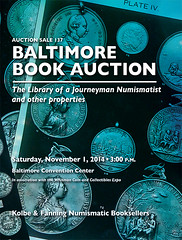 Kolbe & Fanning Numismatic Booksellers wish
to remind everyone that they will be conducting a public auction of important numismatic books on
November 1, 2014 in Baltimore, Maryland, in conjunction with the Whitman Coin & Collectibles
Expo at the Baltimore Convention Center.
Kolbe & Fanning Numismatic Booksellers wish
to remind everyone that they will be conducting a public auction of important numismatic books on
November 1, 2014 in Baltimore, Maryland, in conjunction with the Whitman Coin & Collectibles
Expo at the Baltimore Convention Center.
The sale features the outstanding library of a Journeyman Numismatist and other properties, and focuses on early American numismatics and closely related foreign areas.
The sale will begin at 3:00 pm in Room 306 of the Baltimore Convention Center on November 1. Lot viewing will be held on Thursday and Friday October 30 and 31 from 9:00 am to 5:00 pm and on the day of the sale from 9:00 am till 12:00 noon.
Printed catalogues have been mailed to established clients. A PDF of the catalogue has been posted to the Kolbe & Fanning website. Prospective bidders may also access the live online catalogue and register to bid through the main website at www.numislit.com.
Absentee bids will be accepted via post, phone, email and fax. Bids sent via the post or by fax must be received by Monday, Oct. 27. Bids may be left by phone or voicemail at the (614) 414-0855 number until Monday, Oct. 27. After that date, call (614) 256-8915 to discuss bids anytime before the sale date. Bids will be accepted via email to df@numislit.com anytime before the sale date. Live online bidding will be available through Kolbe & Fanning’s online auction portal at auction.numislit.com (managed through iCollector). Bidders planning to participate in the sale online are strongly encouraged to register in advance.
Kolbe & Fanning Numismatic Booksellers LLC is a licensed auction firm in the State of Ohio and is conducting the sale in conjunction with Jonathan Melnick Auctioneers, Inc., of Baltimore, Maryland. For more information, please see the Kolbe & Fanning website at www.numislit.com or email David Fanning at df@numislit.com. We look forward to your participation.
David F. Fanning, Ph.D.
Kolbe & Fanning Numismatic Booksellers LLC
141 W. Johnstown Rd.
Gahanna, OH 43230
(614) 414-0855
Cell (614) 256-8915
Fax (614) 414-0860
df@numislit.com
www.numislit.com
NEW BOOKS : ENCYCLOPEDIA OF OBSOLETE PAPER MONEY, VOLS 3 & 4
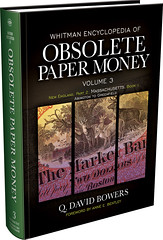
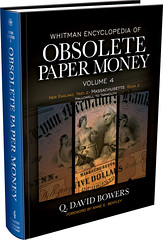
Whitman Publishing announces the upcoming release of volumes 3 and 4 of the Whitman Encyclopedia of Obsolete Paper Money, by Q. David Bowers. Each volume is an 8.5 x 11–inch hardbound book printed in full color on high-quality paper. Combined, they make up 928 pages covering the early bank currency of the entire state of Massachusetts. The books will debut December 1, 2014, available from booksellers and hobby shops nationwide and online (including at www.Whitman.com), for $69.95 each. The books can also be borrowed for free as a benefit of membership in the American Numismatic Association, through the Dwight N. Manley Numismatic Library.
The Whitman Encyclopedia of Obsolete Paper Money is a multiple-volume study of currency issued from 1782 to 1866, before the modern era of National Banks and the Federal Reserve. Over the course of these decades more than 3,000 state-chartered banks issued their own paper money.
In Volume 3, Bowers gives the history of every Massachusetts town and city from Abington to Greenfield, as well as of every bank in those towns that issued this uniquely American currency. Each note is studied, and hundreds are pictured in full color, with information on grading, rarity, values, significant auction results, advice for collectors, and more. Volume 4 offers the same coverage of the towns, cities, and banks from Hallowell to Yarmouth.
“No price and rarity guide has been published on Massachusetts for many years,” Bowers says. “Collectors own thousands of notes that are awaiting proper identification; some of them have the potential to be worth thousands of dollars.”
Active collectors, researchers, dealers, historians, and other experts have volunteered their time and knowledge to help create this new encyclopedia series. The state editor for Massachusetts is C. John Ferreri, and the foreword is by Anne E. Bentley, curator of art and artifacts for the Massachusetts Historical Society.
Earlier volumes of the Whitman Encyclopedia of Obsolete Paper Money included an overview of the field, and coverage of the New England states of Connecticut, Maine, and New Hampshire. Future volumes will cover the rest of New England, the South Atlantic states, the Mid-Atlantic states, the American Midwest, the District of Columbia, and territories.
NEW BOOK: JEWISH ANTIQUES
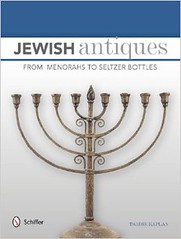 Jewish Antiques from Menorahs to Seltzer Bottles.
Jewish Antiques from Menorahs to Seltzer Bottles.
By Tsadik Kaplan.
Schiffer Publishing Ltd., Atglen PA 19310.
168 pp hardcover, copiously illustrated.
Numismatists are sometimes accused of narrow focus, limiting themselves to coins, medals and tokens and shunning the wider array of items relating to the various fields of collectibles that attract their interest. Author, collector, numismatist and researcher Tsadik Kaplan is not a collector displaying such a narrow focus.
Judaica is a field of great depth and width, and Judaic numismatics dates back to the world of the ancients and spans the continents of the modern world. I became acquainted with author Cohen while I served as a senior cataloger at Stack’s-Coin Galleries in New York City. He arrived at the office from time to time, bearing some of the most amazing and little-known items in his chosen field of study, Judaica.
Jewish Antiques (JA) presents 15 areas of collectibles dealing with religious practice, major holy days, birth and marriage. More specific areas include material created by the historic Bezalel School of designers in Jerusalem, jewelry, Israeli crafts, athletic subjects and Americana. Collectibles relating to the two World Wars receive sensitive and complete coverage.
Exonumia, as the late Russ Rulau dubbed the area of tokens and medals, receives expert treatment. The book skirts the plentiful issues of the modern State of Israel itself, as these have been fairly thoroughly covered by such compilers as the late Sylvia Haffner and Nathan Sobel.
This section opens with Samuel Friedrich Beer’s bronze medal hailing the Second Zionist Congress in Basel, Switzerland in 1898 and includes such important medalets and tokens as a 1913 wearable medalet of Ukrainian Jew Mendel Beiliss who was acquitted of blood libel by an all-Christian jury. Of American interest is the 1863 Civil War Token of the Felix Dining Saloon in New York bearing the word KOSHER in Hebrew.
Author Cohen has researched the virtually unknown area of German Jewish medals issued after the 1933 coming to power of Adolf Hitler and the Nazi Party. Among these is a death centennial medal of Berlin Rabbi Akiva Eger, struck bearing his portrait in September 1937, a year before Kristallnacht and the beginning of the annihilation of the German-Jewish community.
Charitable tokens include several New York City issues of Jewish schools, orphanages and facilities feeding the indigent poor. An entire collection could be assembled by the many institutions issuing the generally brass issues, only a sampling of which appear in JA. Other chapters include medallic objects such as the enameled badge of the Hebrew Veterans of the War with Spain in 1898 and unit badges of the forces of both sides in World War I.
This book is copiously illustrated in full color with hundreds of images of every conceivable Judaic collectible including religious and devotional metalwork, all-purpose woodwork, porcelain, and, yes, seltzer bottles with their richly colored transparent glass. Candelabra, engraved plates and bowls, Mezuzah cases and wall plaques are other collectibles well represented.
The finest printing on coated stock assures the book its consistently handsome appearance, completed by the meticulous color photography that graces virtually every page. Even casual readers with no general interest in Judaic collectibles will find this remarkable book a rare visual treat.
Jewish Antiques from Menorahs to Seltzer Bottles is available from Amazon.com at $35 per copy; as a newly released book from Barnes & Noble at $35, a price likely to rise in 2015. It can be ordered directly from Schiffer Publishing, 4880 Lower Valley Road, Atglen PA 19310 at $45 per copy.
For moe information, or to order on Amazon, see:
Jewish
Antiques: From Menorahs to Seltzer Bottles
(www.amazon.com/Jewish-Antiques-Menorahs-Seltzer-Bottles/dp/0764346504)

NEW BOOK: MEXICAN BEAUTY: MEXICO'S CABALLITO PESO
I would like to bring to the readers' attention a book that was presented at the US Mexican Numismatic Association Convention in Scottsdale, AZ last week.
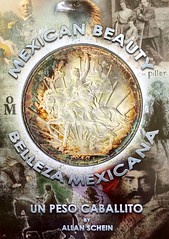 Allan Schein: Mexican Beauty / Belleza Mexicana - Un Peso
Caballito.
Allan Schein: Mexican Beauty / Belleza Mexicana - Un Peso
Caballito.
Salt Lake City, 2014. 238 pp., full color with hundreds of coin photos, text in English and
Spanish.
Mexico's Caballito ("little horse") peso was issued in five consecutive years, from 1910 to 1914. It is considered to be one of the most beautiful coin designs of the modern era.
This book contains comprehensive information on the coin's designer, French medalist Charles Pillet, its design elements and numismatic history, along with valuable information for collectors on date and die varieties, values, grading, toned coins, counterfeits, and more.
The book is bilingual, translated to Spanish by Mexican coin specialist Roberto del Bosque.
While collecting coins from the year of birth of his father, 1914, the author Allan Schein came across the Caballito Peso and fell in love with the issue (despite the fact that the year 1914 is the highly priced key date of the series). Years of intensive research and study have resulted in this ultimate collector's guide.
This is also what I personally see to be the greatest asset of this work: it is a perfect combination of historical background for numismatists interested in Mexican coins or world crowns in general on one side and a detailed insight into the series for the specialized collector on the other.
The book is available from Allan Schein at allan@taekwondograndmaster.com
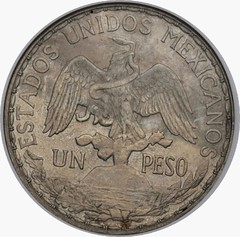
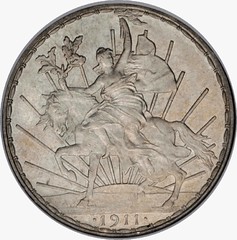
To read Allan's article on the coin, see:
Mexico's Caballito Peso
(taekwondograndmaster.com/Caballito/)
BANCO DE MEXICO ANNOUNCES NEW BOOK AND WEB SITE UPDATE

I'm a recent subscriber of the E-Sylum newsletter and I've found it very useful. I wanted to give readers two pieces of news:
One is that on Friday Mexico's Central Bank presented the book "Escudos, Reales, Pesos y Centavos. Apuntes sobre piezas relevantes de un gran patrimonio histórico de México" by Juan José de la Cruz Arana, Juan Cristóbal Díaz Negrete, Rocío Hernández García, Alberto Quintero Covarrubias and Marina Salcedo Fernández. This is a very interesting book that comments on specific issues about some of the highlights of the numismatic collection of the bank.
The second is that the Bank also is making available to the general public its collection though a renewed website: www.banxico.org.mx/ColeccionNumismatica .
They used to have pictures of some of the coins, but they are extending it to a broader set of items including banknotes, medals and other items from different periods. Here you have a link to the the communiqué www.banxico.org.mx/informacion-para-la-prensa/comunicados/billetes-y-monedas/monedas/%7B8910629B-08A2-AD30-0895-E7023617521F%7D.pdf .
BARBER COIN COLLECTORS' SOCIETY SEEKS JOURNAL EDITOR
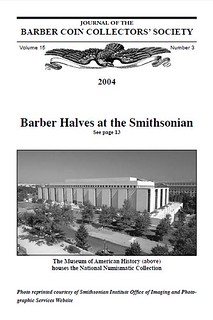 The Barber Coin
Collectors' Society (BCCS) is looking for a new Editor for its Journal, with the upcoming
retirement of long-time Editor, Eileen Ribar. The official publication of the BCCS is a small
Journal, currently published quarterly, and contains research and anecdotal articles written by its
membership and subscribers, information about the Society, and the upcoming calendar of events,
along with several advertisements. This volunteer position requires basic editing and publishing
experience, including gathering the articles and blurbs from members and contributors, assembling
into the Journal, and providing the completed Journal to a printer for publication.
The Barber Coin
Collectors' Society (BCCS) is looking for a new Editor for its Journal, with the upcoming
retirement of long-time Editor, Eileen Ribar. The official publication of the BCCS is a small
Journal, currently published quarterly, and contains research and anecdotal articles written by its
membership and subscribers, information about the Society, and the upcoming calendar of events,
along with several advertisements. This volunteer position requires basic editing and publishing
experience, including gathering the articles and blurbs from members and contributors, assembling
into the Journal, and providing the completed Journal to a printer for publication.
The BCCS will recruit both internally and externally. Basic numismatic knowledge and interest in Barber coinage are certainly a plus but not required. History has shown the BCCS that publication experience is much more important in a Journal Editor than specific knowledge about Barbers or even coins in general.
The BCCS, founded in 1989, is a non-profit numismatic society of collectors and dealers nationwide, with the purpose of increasing and sharing their knowledge of the coins designed by Charles E. Barber. Anyone interested in this important position should contact the BCCS at bccs@barbercoins.org

Archives International Auctions, Part XXI
4th Annual Wall Street Coin, Currency & Collectible Show Auction
Federal Fiscal Documents & Security Printing Ephemera
Highlights include:
- Lot 759 Palestine Currency Board, 1929 High Grade Issue
- Lot 1053 British American Bank Note Company Engravers & Printers
- Lot 400 Richmond and Petersburg Rail Road Company, 1870 Specimen Bond
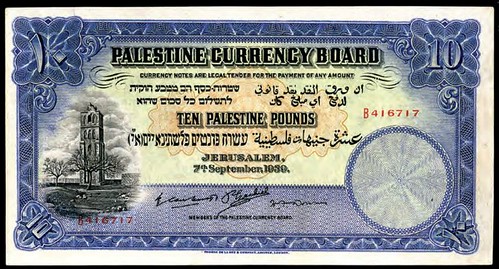
1580 Lemoine Avenue, Suite #7
Fort Lee, NJ 07024
Phone: 201-944-4800
Email: info@archivesinternational.com
WWW.ARCHIVESINTERNATIONAL.COM
MORE ON BLOOM'S LAW
Last week I noted that I couldn't find Bloom's Law in his book, Money of Their Own.
Bob Leonard writes:
It's a footnote on p. 65 of the 1957 (1st?) edition: "Once the Philadelphia Mint ... makes us richer. This is now known as Bloom's Law on the Profitable Inertia of Gold."
François R. Velde writes:
Regarding Bloom's Law, the figure of $5 per $1m or 5 parts per million (ppm) lost by abrasion in one manipulation is in line with other estimates. In the 1830s the French government sorted by year and individually weighed 400,000 silver pieces, to measure wear. They noticed that the coins, after the manipulations were done, had lost in aggregate 16 ppm. The annual loss on gold coins in the 19th c. ranged from 100 to 1000 ppm depending on country and denomination.
To read the earlier E-Sylum article, see:
BLOOM'S LAW OF THE PROFITABLE INERTIA
OF GOLD (www.coinbooks.org/esylum_v17n43a15.html)
NOTES FROM E-SYLUM READERS: OCTOBER 26, 2014
Query: Samuel H. Black Electrotype Plate
Web site visitor Doug Hildreth writes:
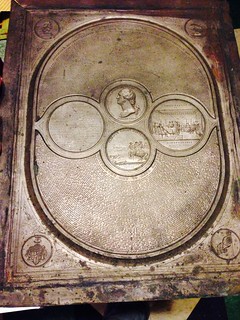 I have what I believe to be a plate from New York City
electrotyper and gilder Samuel H. Black. I have been doing some research on line and came across
your page. I got a lot of information on your page. Are these plates rare? Do they have any value?
Thanks for any help or direction you can give me.
I have what I believe to be a plate from New York City
electrotyper and gilder Samuel H. Black. I have been doing some research on line and came across
your page. I got a lot of information on your page. Are these plates rare? Do they have any value?
Thanks for any help or direction you can give me.
To read the earlier E-Sylum article, see:
DICK JOHNSON ON ELECTROTYPING IN
AMERICA (www.coinbooks.org/esylum_v13n31a16.html)
More on James T. Mangan
Dave Bowers writes:
Nice issue—interesting and varied content as always. The maker of the Celestons was also advertising manager for the Mills Novelty Co. of Chicago.
Frank Van Valen of Stack's Bowers published a short article about Mangan and his Celestons
on his blog this week. To read the complete article, see:
“Does anyone have change for a celeston?”
(http://www.stacksbowers.com/NewsMedia/Blogs/TabId/780/ArtMID
/2678/ArticleID/64809/%E2%80%9CDoes-anyone-have-change-for-a-celeston%E2%80%9D.aspx)
To read the earlier E-Sylum article, see:
MICRONATION STATECRAFT FOR DUMMIES
(www.coinbooks.org/esylum_v17n43a21.html)
Bermania
Paul Bosco writes:
The Micronations list omits Bermania.
To read the earlier E-Sylum article, see:
FEATURED WEB PAGE: MICRONATIONS
(www.coinbooks.org/esylum_v17n43a32.html)
James III
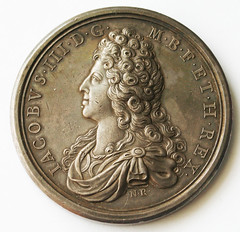 Regarding the 1712 medal on the death of Princess Louisa (on which "Her brother, James III, is
depicted on the obverse"), Chip Howell writes:
Regarding the 1712 medal on the death of Princess Louisa (on which "Her brother, James III, is
depicted on the obverse"), Chip Howell writes:
James the III of what? I wondered. This is the pretender to the English throne for whom the
Jacobite Rebellion is named! Interesting piece, that. See:
http://en.wikipedia.org/wiki/James_Francis_Edward_Stuart
William IIII
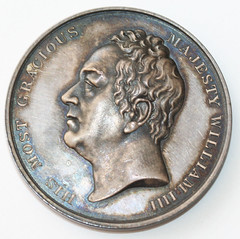 Regarding the "1830 medal: Accession of William III", Chip Howell XX writes:
Regarding the "1830 medal: Accession of William III", Chip Howell XX writes:
Actually, that's William IIII (the 4th), the "Sailor King" who immediately preceded Victoria.
To read the earlier E-Sylum article, see:
WAYNE'S NUMISMATIC DIARY: OCTOBER 19,
2014 (www.coinbooks.org/esylum_v17n43a18.html)
VOCABULARY WORD: ANEPIGRAPHIC
Chip Howell writes:
Why not just "graphic"?
Pablo Hoffman writes:
Some equivalent correlatives of typographic in this context are ideographic, pictographic, or pictorial. Purists among us might hold that the first two of these terms are redundant, since the suffix "-graphic" encompasses both written and pictorial material, but that doesn't disqualify them as answers to your question.
Ralf Böpple writes:
The word "iconographic" came to my mind.
Bob Van Arsdell writes:
Coins without legends are anepigraphic. Celtic coins without legends are uninscribed.
Pablo Hoffman writes:
That was my next answer, but I ran out of electrons.
To read the earlier E-Sylum article, see:
VOCABULARY WORD: TYPOGRAPHIC
(www.coinbooks.org/esylum_v17n43a11.html)
MORE ON SHAPES OF COINS, TOKENS AND MEDALS
Mandorla
Regarding "Mandorola" (Almond-shaped), Bob Leonard writes:
This should be "mandorla".
Rounded Trapezoid
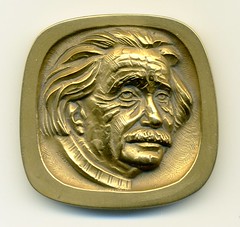 Mel Wacks writes:
Mel Wacks writes:
I think Dick forgot to include the rounded trapezoidal shape of the Jewish-American Hall of Fame medals. Sample is attached. He should know, because he was at Medallic Art Company when they made the first medals in this series beginning in 1969.
Mel's correct. It should have been included. I'm certain there will be other shapes overlooked in my list. The thing about publishing in The E-Sylum, it brings out responses from knowledgeable numismatists. Have I overlooked any others?
Free-form Stellate Pisciform
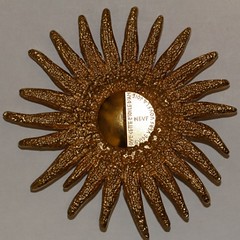
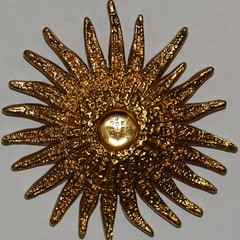
Byron Weston writes:
I thought readers might like to see a Free-form Stellate Pisciform I recently purchased on line.
To read the earlier E-Sylum article, see: VOCABULARY WORD: TYPOGRAPHIC (www.coinbooks.org/esylum_v17n43a11.html)
VOCABULARY TERM: MEDALLIC OBJECTS
 Byron Weston's star-burst design medal was
produced by the Paris Mint in 1972. It was created by Roger Bezombes, one of France's most
prolific artists of this class of medals. He once created a medal of a stork composed of two dozen
scissors. His medallic designs are wild and crazy. So he could be considered a "wild and crazy
guy" (thank you, Steve Martin). Bezombes had 79 medallic items in the Paris Mint catalog of
1981, plus 16 jettons. He is considered the master of creating these items.
Byron Weston's star-burst design medal was
produced by the Paris Mint in 1972. It was created by Roger Bezombes, one of France's most
prolific artists of this class of medals. He once created a medal of a stork composed of two dozen
scissors. His medallic designs are wild and crazy. So he could be considered a "wild and crazy
guy" (thank you, Steve Martin). Bezombes had 79 medallic items in the Paris Mint catalog of
1981, plus 16 jettons. He is considered the master of creating these items.
This medal is Star of Joy. It was chosen as the tenth in a series of medals as the special examples from the Paris Mint's General Collection. It displays the sun in the center and 24 rays (these are not arms as we might be wont to call them) they are sun rays. The sun as center is smooth, polished, and contains the lettering. In contrast, the texture of the rays is style rude, an artistic term meaning rough style. A numismatist would be more apt to call it "rugosity."
QUICK QUIZ: What 20th century U.S. circulating coin did Walter Breen describe as displaying rugosity?
This medal falls in the category of numismatic items called medallic objects, a term created by the Paris Mint, as the title of their 1985 catalog, la Medalle-Object. This catalog was the forerunner and displays the foremost collection of these new art objects.
Medallic objects are the modern art of medals. I once called them bas-relief unleashed, since coins and medals are made from bas-relief models. But that's about as close as they come to traditional numismatic items. They do not have the restrictions of coins, nor the limits of medals. They allow their creator's imagination to run wild and express this in medallic form.
Medallic objects can be struck, but more often are cast. Casting allows them to have unlimited shape, open areas, and freedom of design. Recently they have taken on fabrication of mixed media - metal and other compositions - and multiple parts. Fabrication is a key word here as more are assembled from separate parts, often for a contrasting color effect.
Medallic objects allow their creators more than freedom of design. After all, they are the modern art of the medallic field. And their creators' imaginations do run wild! But this lessens their appeal, it seems, as numismatic traditionalists want only coin or coin-like objects. They appeal more to art collectors, or advanced numismatists interested in art.
I have written extensively on medallic objects. When the international organization of medallists (FIDEM) met at the ANA headquarters in Colorado Springs in 2007 I wrote what I hoped would be the introduction to the Exhibition Catalog. Instead the editors boiled it down to an article in the The Numismatist with some fine medallic illustrations. ANA gave every attendee a copy as well as the organization's members in their monthly magazine.
"Objects of Desire" appeared in the September 2007 issue of The Numismatist. The best part was edited out, however. I claim that America invented medallic objects. For Christmas 1965 Art in America magazine wanted a unique promotion. Their management commissioned a curator at the Museum of Modern Art, Edward Albert Bryant, to create something unique.
Bryant contacted William Louth of Medallic Art Company and the two of them developed the concept of having seven modern art sculptors create miniature works of art that could be reproduced. They picked top artists in the field and commissions went out to Chryssa, Ernest Trova, Roy Gussov, Elbert Weinberg, Harold Tovish, James Wein, and Constantino Nivola.
Response was excellent for the quality and artistic distinctiveness of their creations. Medallic items, large galvanos and two small pins -- in addition to medallion size items -- were offered by Art In America in time for 1965 Christmas gifts. That fixed the date as the first medallic objects ever, created by seven Americans!
The Paris Mint issued their first medallic objects in June 1966. This opened the gate for artists all over the world to create medallic objects. To their credit, the Paris Mint encouraged artists to submit models, virtually underwriting the new media. By the early 1970s the Paris Mint was issuing as many as one new medallic object a day! This was particularly true under the administrating of Pierre deHay (about whom I wrote recently in The E-Sylum).
Unfortunately, Americans could not match this pace. One stands out in my mind, however: Salute to Airmail by Roy Lichtenstein in 1968. Meanwhile, a new organization was established in America, the American Medallic Sculpture Association.
AMSA members quickly adopted the new medallic media. As George Cuhaj (onetime AMSA official, author and Krause publication editor) said in a recent exhibition catalog entry, "I could do this" as he viewed what early members were creating. Since then he has created more than thirty medallic objects.
Among traditional medals are found medallic objects in every exhibition of AMSA, and also of the international organization of medallists (FIDEM) created by artists around the world. While artists like the new media. now 50 years old, medal collectors have yet to embrace it in large numbers.
While Byron Weston embraced his new find -- its shape can best be described as "unusual shape" to answer his question -- he has discovered a new numismatic media to collect. I wish others would follow as well.
To read earlier E-Sylum articles, see:
JOHNSON'S MEDALLIC OBJECTS ARTICLE
FEATURED IN SEPTEMBER NUMISMATIST (www.coinbooks.org/esylum_v10n35a07.html)
MONNAIE DE PARIS COMMEMORATIVE MEDAL
CATALOGS (www.coinbooks.org/esylum_v17n37a22.html)
THE BOOK BAZARRE
U.S. SEMIQUINCENTENNIAL CELEBRATION THOUGHTS
Concerning the proposal to celebrate 250th Anniversary of 1776 Independence in Philadelphia, not mentioned was the 1926 Sesquicentennial (150th Anniversary) celebration in Philadelphia. No one talks about it because it was a complete financial failure.
I do not know what was happening in Philadelphia in 1976. I was living in New York City then and its 1976 (200th) celebration was great - tall ships in the harbor and Hudson River etc. That was a party. There is a distinction between an anniversary party celebration and a World's Fair.
The 1876 Centennial Exposition in Philadelphia was quite different and its purpose was more than a commemoration of US Independence. At Expositions, Exhibitions or World's Fairs, countries competed to show their manufactures and arts.
The last World's Fair to excite wonder and amazement was New York 1939-1940. I do not think that can be recaptured today - for many reasons. As for celebrating Independence in 2026, in Philadelphia - I am sure something will be done in acknowledgement, but without the same feeling as 1876. It is said no one knows or cares about history now. (Obviously, I am not referring to E-Sylum readers and participants!)
To read the earlier E-Sylum article, see:
U.S. SEMIQUINCENTENNIAL CELEBRATION
PLANNERS WANTED (www.coinbooks.org/esylum_v17n43a20.html)
GEORGE MCGOVERN'S $1,000 PROMISSORY NOTE
Loren Gatch wries:
When Fred Reed was editor of Paper Money, he encouraged me to write about strange stuff like political satire notes, and Benny Bolin has been kind enough to keep indulging my interest in this topic.
Forthcoming in Paper Money is the attached article, "George McGovern's $1,000 Promissory Note", about a common example of political scrip that appeared at the Republican National Convention in 1972. We are tweaking the relative size of the photographs and the notes, but the text will run as it is.
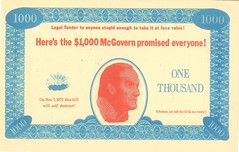
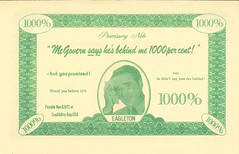
While the word “flip-flop” has been a part of America’s political lexicon since the early 20th century, as a piece of political invective the term has become widespread only in the last generation. As with most political speech, the more it has been used the less it means. Nowadays, almost any apparent inconsistency—or even the intellectually honest act of changing one’s mind—gets a public figure in hot water. Back in 1972, however, “flip-flop” did most definitely describe the behavior of the Democratic Party’s presidential candidate, George McGovern, towards his running mate, Thomas Eagleton. The fiasco of McGovern’s embrace and then disavowal of his vice-presidential choice not only created the “Eighteen-Day Running Mate” but gave rise to a widely-available example of political scrip, George McGovern’s $1000 Promissory Note.
The convention proceedings in Miami Beach stretched on in a way that rushed the selection of McGovern’s vice-presidential candidate. When other alternatives, like Boston’s mayor Kevin White, proved unacceptable, the McGovern forces finally turned to Thomas Francis Eagleton (1929-2007), the junior senator from Missouri. While not as well-known as Kennedy, Eagleton’s Catholicism and his links to organized labor promised to balance the ticket in a similar way. With hardly any vetting of his background, Eagleton was offered a spot on the ticket on July 13 in a phone conversation with McGovern that lasted barely one minute.
It was only after accepting the nomination that Eagleton confirmed rumors that since 1960 he had been hospitalized three times for depression, and twice undergone electroconvulsive—popularly called “electroshock”—therapy. Not only had Eagleton dissimulated in failing to tell the McGovern campaign about these episodes, he continued to resist explaining his medical record in any detail. Eagleton’s stance put the McGovern campaign in a terrible bind. Forcing Eagleton off the ticket would look callous, and destroy McGovern’s image as a different, and more principled, type of politician. Yet keeping Eagleton raised enormous doubts about the competence of a man who might be second in line to assume the presidency, as well as about McGovern’s own sense of judgment.
In a joint press conference with McGovern on July 25, Eagleton first publicly confirmed his past hospitalizations, and McGovern famously declared that “I am 1,000 percent for Tom Eagleton and have no intention of dropping him from the ticket.” The statement was, according to Theodore H. White, “possibly the most damaging faux pas ever made by a Presidential candidate.”
The pushback against McGovern’s decision was intense. The liberal press was against Eagleton; donations to the Democratic Party dried up; and McGovern’s own campaign workers were dealt a demoralizing blow.
McGovern’s unfortunate use of the term “1,000 percent” regarding Eagleton also resonated with one of his earlier campaign proposals to reform the country’s welfare system. McGovern had proposed to give each American a $1,000 payment (a “demogrant”); an idea that, linked with a broader tax reform, actually had a certain academic pedigree and was a forerunner of what later emerged as the Earned Income Tax Credit.
On its face, though, the notion was easy to caricature; Humphrey ridiculed it during the California primary, while Nixon’s campaign director Clark MacGregor called it a “$1,000-perperson giveaway program that would split America permanently into a welfare class and a working class.”
A short time later, during the Republican convention (also in Miami Beach), Scripps- Howard newspapers noted how “funny money—fake $1,000 bills bearing the face of Democratic presidential nominee George S. McGovern—floods convention hotels.” Dispensed over souvenir store counters at the convention, the $1,000 bills sport a red profile of McGovern, facing to his left, framed by blue scrollwork. The text, also in red, reads “Here’s the $1,000 McGovern promised everyone”, “Legal tender to anyone stupid enough to take it at face value”, and with the promise that “On Nov. 7, 1972 this bill will self-destruct.” The reverse (of which there seem to be two varieties, one printed brown, and another green) is labeled a “promissory note” with a portrait of an agitated and perspiring Eagleton mopping his brow. “McGovern says he’s behind me 1,000 percent”, “but…he didn’t say how far behind!” This side is described as “Payable Nov. 8, 1972, at Credibility Gap, U.S.A.”
Crudely printed on the cheapest paper, the parody notes deftly juxtaposed the two lines of attack directed at McGovern’s candidacy: that his policy proposals were too radical for the nation and that his treatment of Eagleton reflected poorly on McGovern’s character and judgment. Reproduced in facsimile in newspapers across the country, the notes themselves quickly showed up at political events as far away as San Antonio, Texas.
The Democrats never recovered from the Eagleton debacle, and the McGovern-Shriver ticket went on to lose in November 1972 by the widest margin of the popular vote in the history of presidential elections. After the Eagleton experience, vice presidential nominees were never again selected so casually and without proper background checks.
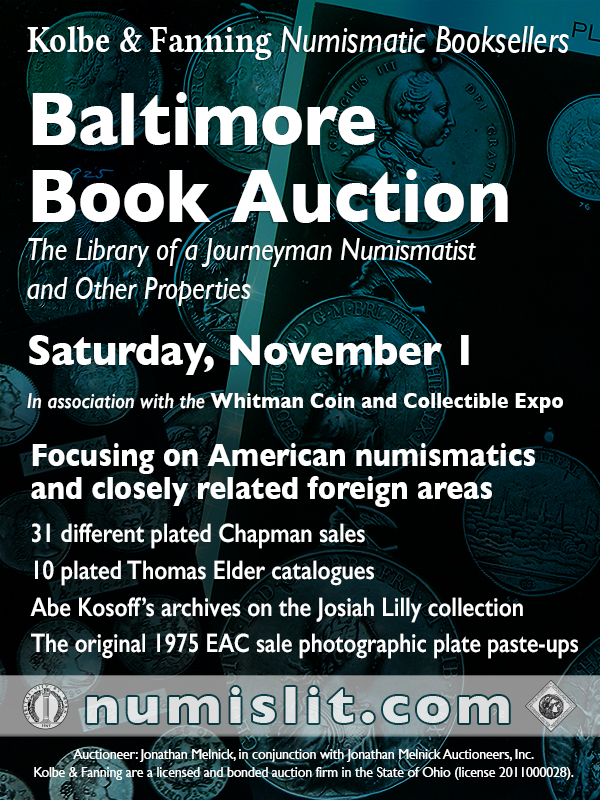
MORE ON THE JOSEPH WRIGHT 1792 PATTERN
I covered the 1792 Quarter dollar patterns and the reverse die with the border of stars in my book on the bust quarters (published 2008). Please find below the section copied from that book.
 "Of the known 1792 dated patterns,
only one was produced that did not state a denomination and also portrayed an American eagle on the
reverse of the coin.
"Of the known 1792 dated patterns,
only one was produced that did not state a denomination and also portrayed an American eagle on the
reverse of the coin.
On the obverse was an elegant portrait of a young, slender, bust of a woman representing lady liberty as prescribed in the mint act. The word LIBERTY is above and the 1792 date below. Liberty’s hair was bound up with a thin ribbon and is not free flowing. There were no dentils and only a small single star was placed to the right of LIBERTY. On the reverse was an eagle motif (also prescribed by the mint act) with wings open and swept back, perched upon a half globe. (This was perhaps derived from the State Seal of New York first developed in 1778). The legend UNITED STATES OF AMERICA surrounds the central eagle/globe motif. There are 87 small five-pointed stars around the periphery perhaps in lieu of dentils (the significance of the number of stars remains a mystery, as well as the single one found on the obverse).
Some previous scholars have postulated a connection between these stars and the ones found on the famous 1794 “starred” reverse die, only seen on the Sheldon-48 Large Cent die marriage. Some have even gone so far as to suggest that they were both produced at the same time and utilizing the same star punch. Most of these theories were put forth when the 1792 pattern quarter was thought to be a pattern for a Large cent. Large cent researcher and author Pete Smith wrote a detailed study in 1986, comparing these two similar dies and came to the conclusion that the stars were not the same size or shape, and were not from the same star punch. The theory of a connection between these dies is just that, a theory. The only similarity comes from the apparent use of a row of stars in place of dentils. The mint did try another type of border on the 1793 Large cents; the beaded border. This experiment and the one utilizing stars was abandoned after 1794 in favor of dentils."
I agree with Tom DeLorey - a blank die with stars from 1792 does not make much sense, however it is possible that the starred reverse large cent die was one that Wright was working on when he succumbed to the yellow fever in late 1793. As stated by Dave Bowers, Robert Scot could have then completed it to create the finished S-48 reverse die. Just a thought...
To read the earlier E-Sylum articles, see:
QUERY: JOSEPH WRIGHT 1792 PATTERN PHOTOS
SOUGHT (www.coinbooks.org/esylum_v17n42a06.html)
NOTES FROM E-SYLUM READERS: OCTOBER
19, 2014 : Counting the Stars (www.coinbooks.org/club_nbs_esylum_v17n43.html)
THE KAISER'S MEDALS
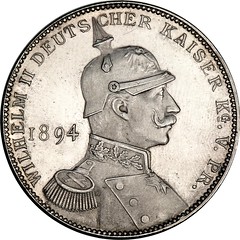
Reconciliation Medal
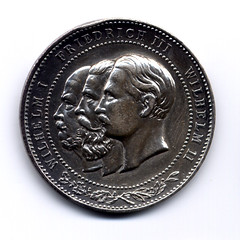
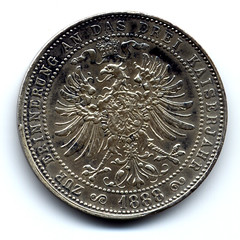
The Three Kaisers

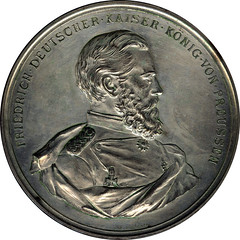
Bruderschaft Medal; Friedrich III Medal

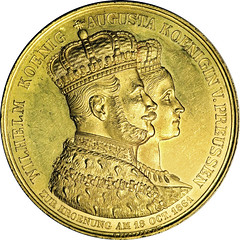
Augusta Medal; Wilhelm I Coronation Medal
THE BOOK BAZARRE
MORE SELECTED LOTS FROM KOLBE-FANNING SALE #137
Lot 23: Bushnell's Account of Three New York Tokens
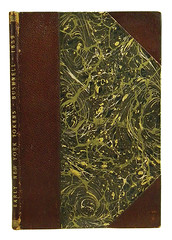 Bushnell, Charles I. AN HISTORICAL ACCOUNT OF
THE FIRST THREE BUSINESS TOKENS ISSUED IN THE CITY OF NEW YORK. New York: Privately Printed, 1859.
12mo, contemporary brown half morocco, gilt, with marbled sides; marbled endpapers; original pink
printed wraps bound in. Lithographic frontispiece depicting a Mott token and two Talbot, Allum and
Lee tokens, printed in metallic ink; 17, (1) pages; advertisement leaf. Near fine.
Bushnell, Charles I. AN HISTORICAL ACCOUNT OF
THE FIRST THREE BUSINESS TOKENS ISSUED IN THE CITY OF NEW YORK. New York: Privately Printed, 1859.
12mo, contemporary brown half morocco, gilt, with marbled sides; marbled endpapers; original pink
printed wraps bound in. Lithographic frontispiece depicting a Mott token and two Talbot, Allum and
Lee tokens, printed in metallic ink; 17, (1) pages; advertisement leaf. Near fine.
A charming copy of this important work. Originally published by Bushnell in a limited large-paper edition, he issued this more commonly encountered (though still scarce) edition to satisfy demand for the work. He continued to add to it, however, issuing a very rare second edition that was generally unknown until the first Kolbe Ford sale. The frontispiece is a lithograph in bronze ink, and the overall production values are well above average. Includes an appendix listing sales of these tokens at auction. The advertisement leaf contains four ads, all by die sinkers. Davis 163.
Lot 83: The Virtuoso's Companion
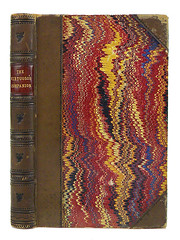
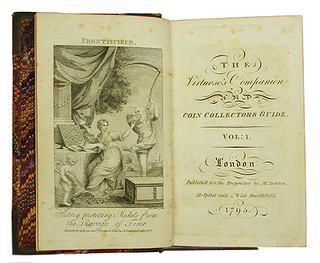
Denton, M. THE VIRTUOSO'S COMPANION, AND COIN COLLECTOR'S GUIDE. London: M. Denton, 1795-96. The first four volumes, bound in one. 12mo, 19th-century brown half calf with marbled boards; spine with four raised bands, ruled and decorated in blind; red morocco spine label, gilt; marbled endpapers; all page edges red. calf. Finely engraved frontispiece; four engraved titles; 120 finely engraved plates, each depicting both sides of four tokens; 15, (1) page index. Slight rubbing, else a fine copy.
An attractive copy of the first four volumes. Issued serially over several years, complete sets of this, the only comprehensive early work depicting 18th-century English tokens, are today decidedly rare. The preface proposed to issue "fac-similes of four hundred and eighty different Coins, in four Volumes twelves, with an elegant frontispiece, at the price of twenty shillings." After the four volumes here present had appeared, such a wealth of tokens remained un-illustrated that it was decided to extend the series to eight volumes.
Initiated by Denton, the last two parts were published by Thomas Prattent. The work appeared at ten- to fourteen-day intervals in printed wrappers, price sixpence: twelve tokens of three plates comprising a number. Given the method of distribution, the change in publisher (many sets are comprised of only the first 180 plates), and the proclivity of early collectors to cut up plates to illustrate other books (the famous Conder work, for example), it is not surprising that few complete sets have survived.
Lot 96: Elder's Miller Sale Catalogue
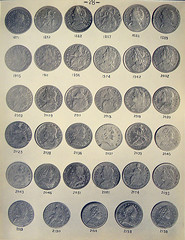
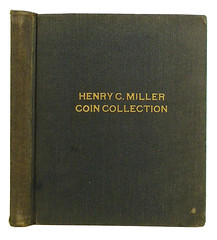
Elder, Thomas L. CATALOGUE OF THE SPLENDID RARE COIN COLLECTION OF THE LATE HENRY C. MILLER, ESQ. New York: Daniel R. Kennedy, Auctioneer, May 26-29, 1920. Small 4to [25.5 by 21.5 cm], original black cloth, upper cover lettered in gilt. 154, (6) pages; 2212 lots; 28 superb photographic plates on original cloth hinges. Original prices realized list laid in. Binding slightly rubbed. Near fine.
A magnificent collection of early English coins, Roman silver coins and important American colonial coins. By far best remembered today, however, for including Miller's collection of Connecticut coppers, on which he wrote what is still the standard reference (based partly on prior work by Dr. Thomas Hall).
Plated Miller sales are noted rarities and have always been desirable: in his description of a copy in a 1929 auction catalogue, Elder wrote: "Very rare. Not over 8 or 10 Plate catalogs were issued. Probably none other to be had anywhere for sale. Ought to bring $15 to $20." (The market for these has, suffice to say, increased.)
The first eight plates depict British coins from Celtic times to Queen Victoria, including several Roman Republican coins; the ninth through twenty-second plates illustrate a wide variety of ancient Roman coins, along with a few Byzantine pieces and several coins of Roman Egypt; and the final six plates are devoted to American colonial coins.
Rare, especially in the original binding. Adams 172. Clain-Stefanelli 14081. Davis 365. Ex Richard Picker library (June 1984 Kolbe sale, lot 267).
For more information on the sale, see:
www.numislit.com
ENCASED POSTAGE STAMPS IN THE STACK'S BOWERS 2014 BALTIMORE SALE
1862 Dougan the Hatter. Three Cents
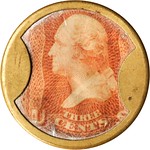

Trow's New York City Directory for 1865 provides the following: "Dougan John A. hats, 102 Nassau, h. 113 Macdougal." Dougan was affiliated with New York 12th Regiment, Infantry, and during the Civil War is said to have been active in helping to recruit and equip soldiers in the regiment at his own personal cost. Mr. Dougan, with business premises in New York City, was one of three of John Gault's customers engaged in the hat trade; the other two were F. Buhl & Company in Detroit and White, who was also located in New York City. Dougan's encasements are the only ones in the series to bear an illustration of the product advertised -- a top hat.
To read the complete lot description, see:
1862 Dougan the Hatter. Three Cents (www.stacksbowers.com/BrowseAuctions/LotDetail/
tabid/227/AuctionID/6039/Lot/3213/Default.aspx)
1862 Lord & Taylor. Three Cents
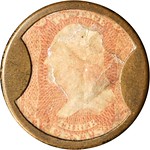
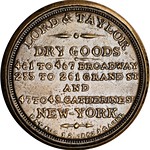
By 1862, when the firm commissioned their encasements from Gault, Lord & Taylor was a leader in fashions and had three business locations. The first was at 255-261 Grand Street; a second was located slightly north, at 47-49 Catherine Street; while the flagship store was at 461-467 Broadway, then New York's most fashionable thoroughfare. Headquarters was described at the time as "more like an Italian palace than a place for the sale of broadcloth." This building was attacked during New York's draft riots of 1863, but was successfully defended from the mob by the store's own clerks (the police deliberately avoided the riot scene, partly out of sympathy with the rioters). Today in 2014 the firm remains famous, the only issuer of encased postage stamps for which this can be said.
To read the complete lot description, see:
1862 Lord & Taylor. Three Cents. (www.stacksbowers.com/BrowseAuctions/LotDetail/
tabid/227/AuctionID/6039/Lot/3221/Default.aspx)
1862 N. & G. Taylor & Co. Three Cents

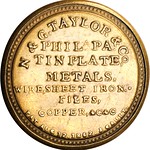
The following is from the 1863 edition of the McElroy's Philadelphia City Directory: "Taylor N. & G. & Co. (G.E. & W.Y. Taylor, & Augustus R. Hall), tin plate, metals, & c., 303 Branch." This firm also issued many Civil War tokens in a number of die varieties.
To read the complete lot description, see:
1862 N. & G. Taylor & Co. Three Cents. (www.stacksbowers.com/BrowseAuctions/LotDetail/
tabid/227/AuctionID/6039/Lot/3227/Default.aspx)
ARTICLE PROFILES SILVER BARON NELSON BUNKER HUNT
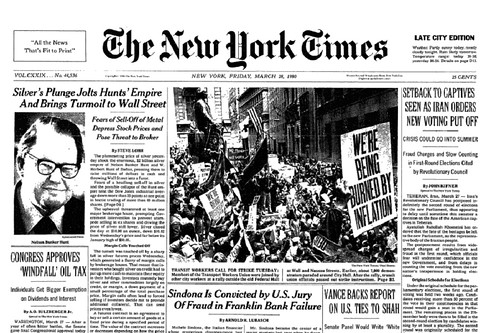
Nelson Bunker Hunt, the billionaire oil tycoon who once tried to corner the world's silver market, died yesterday in Dallas at the age of 88. He was an heir to the Hunt oil fortune and at one time, among the richest people on the planet. But a huge bet on the silver market in the late '70s led to a silver craze and a financial debacle.
Hunt's obituary in The Dallas Morning News describes him as an oilman, patriot, horseman, Christian and John Birch Society member, among other things. But in financial circles he and his brother were best known for owning a frighteningly big chunk of the world's silver. They wanted to hedge against raging inflation, they said.
"They bid up the price of silver from $9 an ounce to, at its peak, something like $50 an ounce in January 1980," said John Coffee, a professor at Columbia University.
But when worried regulators set new trading limits on silver, the Hunts couldn't meet a margin call. Silver prices collapsed, they lost over a billion dollars, their lenders were in trouble, and yes, a federal bailout of sorts ensued. Hunt declared bankruptcy – the largest personal bankruptcy in American history.
Jim Stone, who chaired the Commodity Futures Trading Commission at the time, today said the silver crisis "nearly torpedoed top financial institutions in much the same way mortgage derivatives did in 2008." The Hunts were highly leveraged, and that problem, Stone says, remains "unfixed" and "the lesson unlearned."
To read the complete article, see:
The
oil man who caused a silver craze - and bust
(www.marketplace.org/topics/economy/oil-man-who-caused-silver-craze-and-bust)
To read the Dallas News obituary article, see:
Nelson Bunker Hunt, second son of legendary wildcatter H.L. Hunt, dies
(www.dallasnews.com/obituary-headlines/20141021-nelson-bunker-hunt-second-son-of-legendary-wildcatter-h.l.-hunt-dies.ece)

ARTICLE PROFILES CANADIAN COLLECTOR GEORGE MANZ
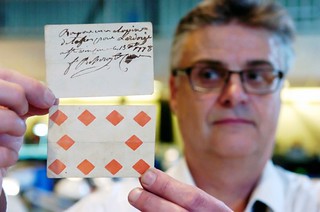 It was the Canadian Tire money of its day - some
two centuries ago.
It was the Canadian Tire money of its day - some
two centuries ago.
Avid coin collector George Manz points to two wellpreserved playing cards. On their face, they look like nothing more than a 10 of diamonds and a seven of clubs.
"They're priceless," said Manz, manning his table at the Regina Coin Club's fall show on Sunday.
That's because if you flip those cards over, there's some inky scrawl written on the back and a date, on the clubs, of 1778.
The playing card money was a highlight of this weekend's show, said Manz, club president.
At a time when hard currency could be in short supply, some enterprising merchant in what's now Quebec made his own with playing cards. It's believed one of the cards was good for the purchase of a bottle of rum, the other for a pint of rum.
Manz, who often digs into the history books to learn more about his collection, said playing card money in what would become Canada began in the late 1600s when it was used to pay the troops in New France. The ships carrying real currency were sometimes delayed. The playing cards fit the bill until the real stuff arrived so the troops had spending money. Given the high illiteracy rates of the day, the cards were often cut in half or quarters to symbolize varying denominations.
Manz bought his two cards at an auction in Toronto. He's since shown them to experts in Canada and the U.S. "They have never seen anything like these," Manz said proudly. "They're extremely rare."
They weren't the only unique find on display.
Ever hear of the Moose Jaw-based Bank of Saskatchewan?
In this next-year country, a group of Moose Jaw businessmen believed in 1912 that it would be a going concern, so had proofs made for the money.
They had to come up with $250,000 - which they hoped to raise through shares - to put in trust in order to get government approval.
To boost the sale of shares, the wannabe bankers displayed proposed bank notes in several store windows on Main Street. But not enough people were buying.
The displayed bank notes were optimistically dated May 1, 1913.
"A lot of people lost money," said Manz, noting the shares sold for $100 a piece.
Manz owns the only known tintype mirror proofs for the $20 Bank of Saskatchewan note that wasn't to be, while Gatewest Coin Ltd., of Winnipeg, had the approval proofs for the bills on display.
"It was artwork back then," noted Gatewest employee Christopher Porco. The $10 bill has a beautifully detailed scene of railway construction, while the $20 bill shows the bustling Moose Jaw rail yards. In 1913, the aspiring bank project collapsed, and its fate was sealed the next year.
"World War 1 came and wiped everyone out," he noted.
In 1935, currency was standardized - all issued by the Bank of Canada.
To read the complete article, see:
Cards
and currency capture history
(www.leaderpost.com/life/Cards+currency+capture+history/10306371/story.html)
THE TOKENS OF DANIEL TOKAR
Web site visitor Daniel Tokar of The Willow Forge in Shepherdstown WV writes:
I came across the story you posted on the O'Hurley General Store tokens. Got to laugh a little from it because I am the man who made the dies and struck the tokens in that shop. Around 1996 we had a job that used some 1/8" thick brass, clips and pieces left from the job were too small to make into much so I had the idea to turn them into "Money" . This was not my first die sinking work, I have made over a dozen coin dies. Mostly for SCA re-enactors and fun "keychain" tokens. Attached are coin die and punch impressions from some of my projects. 25443
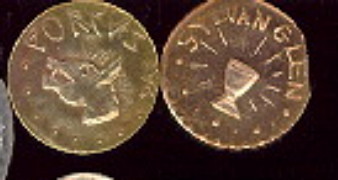



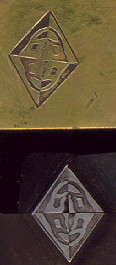

To read the earlier E-Sylum article, see:
A MODERN "GOOD FOR" TOKEN FROM
SHEPHERDSTOWN, WV (www.coinbooks.org/esylum_v17n16a13.html)

AUSTRALIAN WILDFIRE HERO RECEIVE PAPAL GOLD MEDAL
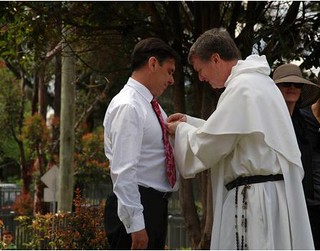 St
Thomas Aquinas school principal Serge Rosato was honoured with a "rare" medal from the
Pope on Friday during a moving service at the school to commemorate a year on from the fires.
St
Thomas Aquinas school principal Serge Rosato was honoured with a "rare" medal from the
Pope on Friday during a moving service at the school to commemorate a year on from the fires.
During the ceremony, Sydney Archbishop-elect Anthony Fisher, delivered a message from Pope Francis honouring the "heroic" Mr Rosato by awarding him the Gold Papal Medal, the Benemerenti medal, for his "exceptional" service and "great leadership to his community" while his own home burnt to the ground. It was originally an award given to soldiers in the Papal Army and has been bestowed since 1832.
Archbishop-elect Fisher said he had only learned that morning of the medal.
"I asked for it and we had heard nothing - incredibly it arrived today," he told the Gazette after the service.
"It's a very unusual [honour]. In Rome they got a sense that something special happened here."
Mr Rosato lost his home while he was evacuating the 550 children from St Thomas's. The fire had come through a valley between St Columba's Catholic College [where Mr Rosato's 17-year-old twins were in lockdown for five hours] and St Thomas Aquinas, and was believed to be started by powerlines in Linksview Road.
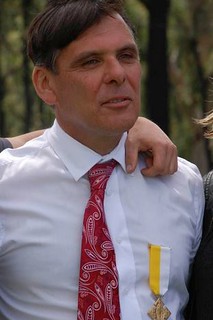 Mr Rosato said he "had a strong sense that
we didn't have a lot of time before it would be at the school".
Mr Rosato said he "had a strong sense that
we didn't have a lot of time before it would be at the school".
He led his students and staff on a 2.5km walk to safety while flames closed in around the school, walking past Paulwood Avenue and on to Hawkesbury Road where several homes burned and out to the Winmalee Shopping Centre. Three children had asthma attacks and one disabled child had to be carried by a teacher almost the entire way during the exodus out to the shops, where donuts and other goodies were offered while they waited out the firestorm.
"The actions of Mr Serge Rosato were heroic and exceptional," said Archbishop-elect
Anthony Fisher.
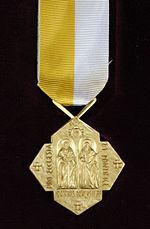 The Pro Ecclesia et Pontifice (Latin: For
Church and Pope) medal is an award of the Roman Catholic Church. It is also known as the
"Cross of Honour". The medal was established by Leo XIII on July 17, 1888, to commemorate
his golden sacerdotal jubilee and was originally bestowed on those men and women who had aided and
promoted the jubilee, and by other means assisted in making the jubilee and the Vatican Exposition
successful.
The Pro Ecclesia et Pontifice (Latin: For
Church and Pope) medal is an award of the Roman Catholic Church. It is also known as the
"Cross of Honour". The medal was established by Leo XIII on July 17, 1888, to commemorate
his golden sacerdotal jubilee and was originally bestowed on those men and women who had aided and
promoted the jubilee, and by other means assisted in making the jubilee and the Vatican Exposition
successful.
It is currently given for distinguished service to the church by lay people and clergy. It is the highest medal that can be awarded to the laity by the Pope.
To read the Wikipedia article, see:
Pro Ecclesia et Pontifice
(http://en.wikipedia.org/wiki/Pro_Ecclesia_et_Pontifice)
To read the complete article, see:
Bushfire hero Serge Rosato awarded medal from the Pope
(www.bluemountainsgazette.com.au/story/2638879/bushfire-hero-serge-rosato-awarded-medal-from-the-pope/?cs=1180)
ROYAL AUSTRALIAN MINT 50TH ANNIVERSARY COIN
 The
Royal Australian Mint has just started accepting preorders for a number of new product releases.
This includes uncirculated and proof sets which incorporate a special coin to mark the 50th
anniversary of the Mint in 2015. Other coins feature the Great Barrier Reef, Eternal Love, and the
Alphabet. The latest Remembrance Day, Australia at War, and ANZAC Cententary Coin Program releases
are also available.
The
Royal Australian Mint has just started accepting preorders for a number of new product releases.
This includes uncirculated and proof sets which incorporate a special coin to mark the 50th
anniversary of the Mint in 2015. Other coins feature the Great Barrier Reef, Eternal Love, and the
Alphabet. The latest Remembrance Day, Australia at War, and ANZAC Cententary Coin Program releases
are also available.
All of the coins and sets can be found in the new releases section of the Royal Australian Mint website. Preorders can be placed now, with the new coins to begin shipping on October 24 or 30, 2014.
The Royal Australian Mint is celebrating its 50th anniversary with the release of Six Coin Year Sets which contain a unique 50 cent coin with a honeycomb design. The Royal Australian Mint had opened on February 22, 1965 and was tasked with producing Australia’s circulating coins for the changeover to decimal currency. The special coin with the honeycomb design is intended to represent the expertise and ingenuity of the employees of the mint who make world renowned coins.
To read the complete article, see:
Royal Australian Mint Marks 50th Anniversary and Other New Releases
(world.mintnewsblog.com/2014/10/royal-australian-mint-marks-50th-anniversary-and-other-new-releases/)
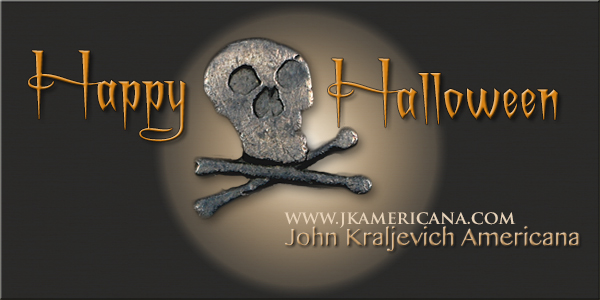
DENMARK'S CENTRAL BANK TO OUTSOURCE BANKNOTE PRODUCTION
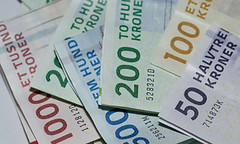 With more and more people paying with credit cards and their
smartphones, Denmark’s central bank Nationalbanken says it no longer pays to print banknotes or
mint coins.
With more and more people paying with credit cards and their
smartphones, Denmark’s central bank Nationalbanken says it no longer pays to print banknotes or
mint coins.
By the end of 2016, Nationalbanken plans to outsource all of its printing and minting services to an external supplier.
“Although the amount of cash circulating in Denmark continues to be high, society’s demand for new banknotes and coins has been falling for years, and Nationalbanken has no expectations that the trend will be reversed,” the bank wrote in a press release.
In addition to the rise in alternative paying options, the central bank also said that today’s banknotes and coins are better recirculated into the economy and made of a better quality that ensures a longer shelf life. When viewed as a whole, the bank has determined that note and coin production is no a longer financially sound option.
The bank said that the move to an external supplier will result in a total savings of 100 million kroner ($17.2 million) through 2020.
In its statement, the bank stressed that having notes and coins produced externally would not affect the bank’s central role.
“Nationalbanken will continue to be the issuing authority for banknotes and coins and will maintain its expertise in the area of notes and coins. It is only the internal production of the notes and coins that will henceforth by done by external suppliers,” it wrote.
To read the complete article, see:
Denmark's
central bank to stop producing money
(www.thelocal.dk/20141021/denmarks-central-bank-to-stop-producing-money)
ARTICLE HIGHLIGHTS BANKNOTE ANTI-COUNTERFEITING FEATURES
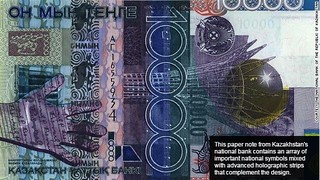 Norges Bank, the Norwegian central bank, held a
competition to design the front and back of the new note, which will come into circulation in 2017.
The winning designs, announced earlier in October, were submitted by Norwegian graphic designers
The Metric System -- Terje Tonnessen and Snohetto.
Norges Bank, the Norwegian central bank, held a
competition to design the front and back of the new note, which will come into circulation in 2017.
The winning designs, announced earlier in October, were submitted by Norwegian graphic designers
The Metric System -- Terje Tonnessen and Snohetto.
According to Norges Bank, the winning designs display "artistic flair" that emphasize Norway's close relationship with the sea, but are also "suited to the incorporation of necessary security elements." These will include machine-readable elements and anti-counterfeiting measures.
Such high-tech accoutrements are now a common feature of the most modern banknotes. But art, the aesthetic and items of cultural significance are also a major consideration when designing the latest money.
According to the curator of the British Museum's Modern Money Collection, Thomas Hockenhull, the art by itself isn't a particularly reliable security feature given the "advancement of scanning and printing technology."
"Those are maintained primarily to preserve public confidence in the note," Hockenhull said.
But, he added, when combined with complex measures like watermarks, moving color elements and the latest in polymer and paper technology, a detailed image can make forgery more difficult.
The Bank of Canada has produced bills in recent years that illustrate this elaborate synergy. Holographic and transparent features accompany state-of-the-art calligraphy that officials claim is nearly impossible to duplicate.
Instead of using paper, the newest Canadian notes are made from a polypropylene substrate and feature a large transparent window through which you can see a metallic portrait above a metallic building. Beneath the portrait the word "Canada" is also transparent and is slightly raised.
Other security features include a smaller frosted window with a maple leaf design, which has a transparent outline and contains hidden numbers only visible when lit up with a small light.
Similar plastic and transparent elements can be found on the latest colorful currency from the likes of Guatemala, Australia and Nicaragua, Chile and Malaysia.
To read the complete article, see:
Countering
the counterfeiters: The art of making money
(http://us.cnn.com/2014/10/22/business/countering-the-counterfeiters-art-money/index.html)
THE BOOK BAZARRE
WAYNE'S NUMISMATIC DIARY: OCTOBER 26, 2014
Washington Numismatic Society
Tuesday night I left work with a new destination programmed into my GPS. I had been invited to
speak at the October 2014 meeting of the Washington Numismatic Society. Although I live in the
metro area I had never been to the club, which meets in Washington, D.C.
The traffic and rain made for a unpleasant but luckily uneventful commute, unless you count the serpentine course my GPS system decided upon to guide me to my destination. Somehow I made it to the right street and parked my car. I opened my umbrella against the steady rain.
I was unfamiliar with the venue, a church building on Massachusetts Avenue. I saw a light inside and walked around to the nearest door. I opened it and went inside. Rather than finding a meeting room I observed a little old lady at work in an office. I asked her where the club meeting room was, and she offered to show me but asked, "How did you get in here?"
"Through the door there." "And it was unlocked??" Yep - it was unlocked. But it wasn't supposed to be. Some workmen had forgotten to lock up. The lady was as sweet as could be, though. After locking the door she led me through the sanctuary and down to the basement meeting room. She propped open the new door the workmen had just installed. It was lucky I'd arrived when I did, for the club members did not have the new key.
They soon began to arrive and one of the first was my host for the night, Wayne Wilcox, who had invited me to speak. I helped set up some of the tables and chairs. President Simcha Kuritsky arrived as well, and he set up a projector. Around fifteen members and guests settled in for the meeting.
After holding some club business and breaking for snacks, I began my presentation on the "Past, Present and Future of Online Numismatics", a reprise of my talk at the August Numismatic Bibliomania Society meeting. I recapped the history of computers and the Internet, online forums like rec.collecting.coins, and the creation of The E-Sylum. Moving on to the future, I discussed the CoinLibrary site I'm working on.
I enjoyed meeting everyone and seeing the exhibits, which included some nice Alexandria and D.C. scrip notes. But it made for a long day and I was glad to get back home around 11pm.
The PAN Show
On Friday I worked half a day and joined my family for a trip to Pittsburgh to visit my wife's
family and my sister. Because our trip coincided with the Pennsylvania Association of Numismatists
show, I was able to spend a few hours there Saturday. Thanks to Pat McBride for providing the below
photos.
My wife dropped me off at the convention center and I soon found myself talking with a number of old Pittsburgh numismatic friends, including Dick Gaetano, Rich Crosby, Larry Dzuibek, Ed Krivoniak and Don Carlucci. Bryce Doxson of Maryland was also on hand at the exhibit area. There are a number of great exhibits. I didn't take notes, but two that stood out for me were one on Morse Code on coins and medals, and an amazing one on a 13-note short snorter, which stretched several feet across a custom-built showcase.
The 1715 Fleet Society
I also stopped at the table of Ben Costello and the 1715 Fleet Society. Ben had an absolutely
jaw-dropping exhibit of sea salvage coins and artifacts primarily from the 1715 Fleet, but also The
Atocha and other famous wrecks. I was particularly fascinated with a 50-pound silver bar from The
Atocha.
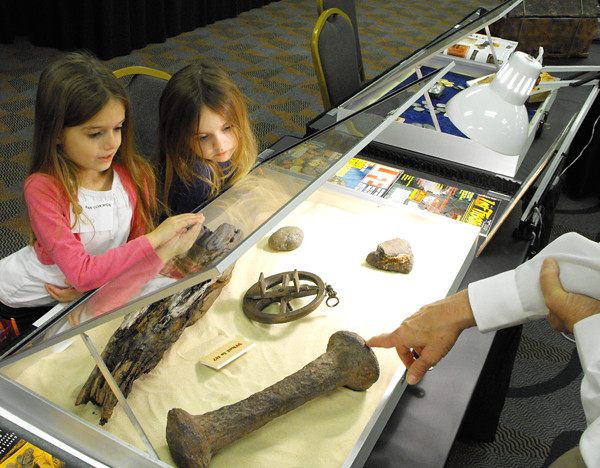
Bob Evans and the SS Central America
I sat in the front row for Bob Evans' presentation on his work recovering coins, ingots and
other artifacts from the wreck of the SS Central America. I counted about 100 people in the room.
It was a rapt audience that paid close attention to his first-hand accounts of REAL treasure
hunting and how it's not quite like what people might envision from the Hollywood treatment of
the subject. Bravo!
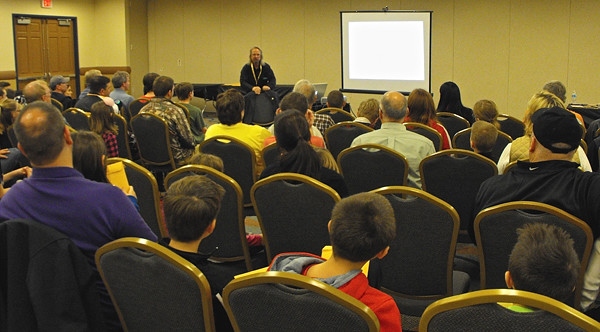
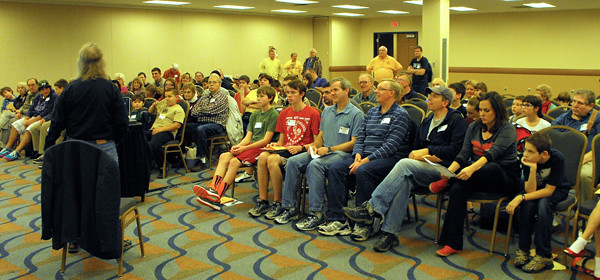
Kevin Flynn and Coin Collecting
Bob was followed by Kevin Flynn who gave a nice presentation of his own on coin collecting.
Afterwards I helped out with the auction. Bob Stakeley of the Pittsburgh History Center expertly
called the 50 lots while me, Dick Gaetano and Corleen Chesonis were the "runners" giving
winners their lots and collecting their auction dollars. I was very glad to be able to be there.
Seeing the great crowd was a "George Bailey" moment for me (from one of my favorite
films, "It's a Wonderful Life"). I'd helped start the program some twenty years
ago and it was fantastic to see it not only continuing, but thriving. Congrats to PAN for keeping
the flame of numismatics alive for the next generation of collectors.
THE BOOK BAZARRE
THE TINIEST ANCIENT COINS
In 2014 the British Royal Mint issued a gold proof 50p coin only 8 mm in diameter*, weighing in at 1/40 Troy ounce (0.8 grams.) This is the smallest coin the UK has ever struck and surely one of the smallest modern coins. For comparison, the smallest coin the US Mint has ever produced–the US gold dollar, struck in several designs from 1849 to 1889–weighed 1.672 grams and measured 12.7 to 14.3 mm.
Compared to the smallest coins of Antiquity, these little trinkets are big bruisers. In this article we will explore just how tiny coins can get.
There are three ways a coin can be tiny: weight, dimension (diameter and thickness), and value. The Latin motto of the American Numismatic Society is Parva Ne Pereant: ”let not the small things perish.” The survival of so many extremely small coins from the remote past shows how appropriate this slogan is for people who treasure ancient coins.
Metrology is the study of weights and measures. With relentlessly logical minds, but lacking the advantage of decimal notation, ancient Greeks created systems of weights based on simple fractions. These became the basis of their coinage denominations.
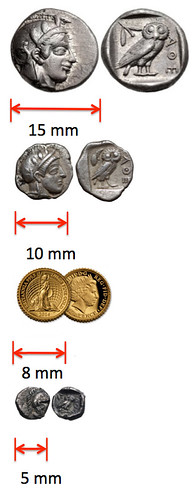
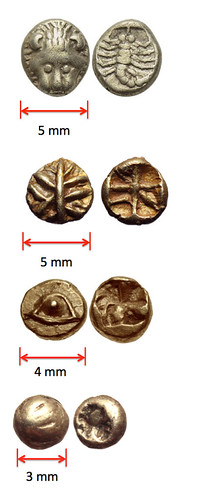
To find the tiniest ancients we have to go even further back in time, to the electrum coinage of Lydia and the Greek cities of Asia Minor.
Like most questions in classical numismatics, the dating of these coins is controversial, but circa 650 BCE is the earliest guess for unmarked types and ca. 630-620 for types stamped with designs. The weight standard was based on a stater of about 14 grams, worth three month’s salary for a mercenary. Because electrum was so highly valued, most of the coins were smaller; thirds, sixths, twelfths, and twenty-fourths. The 1/24 stater, weighing about 0.57 grams and measuring only about 6 mm in diameter, could purchase a sheep or a bushel of grain (Linzalone).
But the need for even smaller units in the day-to-day transactions of city life led to the production of miniscule 1/48 and 1/96 staters. At 3 or 4 mm in size, weighing just 0.15 to 0.10 grams, these are the smallest coins issued in the ancient world. I find it easier to avoid the decimals and just think of the weight as 150 to 100 milligrams. To keep this in perspective, an aspirin tablet weighs 325 milligrams.
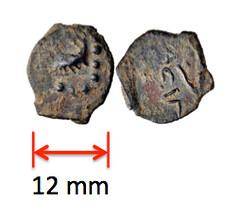
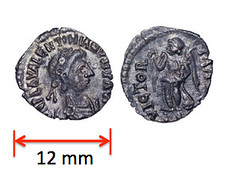
By the fifth century, inflation had reduced the value of Roman copper small change to nearly nothing. The names of the denominations are often uncertain, so numismatists use a code based on the diameter of the coins. The smallest denomination is designated as AE4 and it was probably called a nummus, which simply means “coin”.
In the local coinage of first century Judea, the smallest denomination was a bronze coin called a lepton in Greek and a half prutah in Hebrew. The smallest denomination coin known to the translators of the King James Version of the Bible (begun 1604, published 1611) was the Flemish mijt or “mite,” a debased silver piece of about 0.7 gram, worth half a farthing or 1/8 of a penny. It never circulated in England, but the word was familiar enough to contemporary readers that “mite” was used to translate lepton.
The smallest coins are likely to have a low survival rate, which makes them relatively scarce. For most collectors, they lack the “eye appeal” of their larger cousins. They seldom appear in major auctions, and few dealers have many in stock, so they can be quite challenging to collect.
The upside of this is that when they do appear on the market, they can be quite affordable. Well-worn, poorly struck examples of the bronze “Widow’s Mite,” commonly found in large numbers in the Holy Land, can often be purchase for under $20.
To read the complete article, see:
Small
Change: The Tiniest Ancient Coins
(www.coinweek.com/featured-news/small-change-the-tiniest-ancient-coins/)
THE ART AND CRAFT OF FORGER MARK LANDIS
Conservators have an uneasy relationship with forgery. Often knee-jerk reactions arise: outrage, indignation, feelings of being duped, and sometimes a closet admiration of a particular craft skill. While certainly valid, and generally true, they can be somewhat of a conversation stopper. Deep down, I find myself a bit envious that forgers get so much media attention, and that this attention is generally overwhelmingly sympathetic. Conservation is just as interesting, right?
The movie Art and Craft tells the story of Mark Landis, a contemporary forger. It is an entirely enjoyable film, the directors allow Landis to show and tell his story with little interference. The film clearly articulates his reasons and motivations for forgery while not becoming overly romantic. Landis, a diagnosed schizophrenic, is shown visiting his therapists and at home, generally watching tv and copying pictures from art books at the same time. He is quite likely more a victim of “the system” more than someone taking advantage of it. A couple of times he is shown engaging in quotidian activities; eating a dinner of melba toast dipped into a container of margarine, for example.
Early on, the film reveals his primary motivation for creating forgeries: he wants to be a philanthropist. But he realizes quite quickly it is hard to be a philanthropist without money or art to give away; he had to create the art in order to distribute it. Also, he liked being treated like a philanthropist, and he admits becoming addicted to it. Who wouldn’t? So he keeps making more forgeries. The film delves into his personality, much of which seems to be strongly influenced by a tv that always seemed to be on. He is self-aware of these influences, and tells others of their source. For example, he started smoking because he saw characters in 1940's movies smoking to calm down, so he thought it would help calm his nerves, and curb his compulsion to pace.
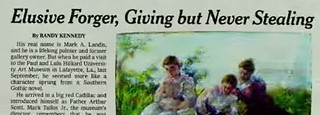
The film emphasizes the naturalness, almost an innocence, of his desire to copy works of art. The motivations behind many forgers (which are generally not pecuniary by the way) are often egotistically motivated: proving oneself equal to the great artists or “getting even” with the art experts by exposing their ignorance. In addition to his philanthropic desires, Landis also simply likes to copy things, again because it calms him down. Repetitive hand motions and using hand-eye coordination is comforting to him. Sound familiar?
The antagonist in this film is a Matthew Leininger, a museum registrar, who originally noticed a number of identical paintings in numerous museums, and over the years slowly closed in on Landis. When seeing some of the paintings, the audience wonders how they could have fooled anyone. Many are not of Eric Hebborn or Elmyr de Hory caliber, though Landis is certainly capable of finely crafted work. Many of his forgeries are a color photocopy of a work with acrylic medium smeared on the surface, to resemble brushstrokes. The materials he uses are all standard off the shelf art supplies from Michaels, and the frames from Home Depot, though he slightly antiques them. He often photocopies a certificate of sale from a major auction house or defunct gallery to aid in establishing provenance and adheres this to the back.
To read the complete article, see:
The
Movie "Art and Craft": A Conservator's Perspective
(www.conservators-converse.org/2014/10/the-movie-art-and-craft-a-conservators-perspective/)
THE CASE AGAINST REPATRIATING MUSEUM ARTIFACTS?
James Cuno, President and CEO of the J. Paul Getty Trust, previews his new book Museums Matter: In Praise of the Encyclopedic Museum and Who Owns Antiquity? for Foreign Affairs magazine:
In the battle over cultural heritage, repatriation claims based strictly on national origin are more than just denials of cultural exchange: they are also arguments against the promise of encyclopedic museums — a category that includes the Metropolitan Museum of Art, in New York; the British Museum, in London; and the Louvre, in Paris. By presenting the artifacts of one time and one culture next to those of other times and cultures, encyclopedic museums encourage curiosity about the world and its many peoples.
They also promote a cosmopolitan worldview, as opposed to a nationalist concept of cultural identity. In an era of globalization that is nonetheless marked by resurgent nationalism and sectarianism, antiquities and their history should not be used to stoke such narrow identities. Instead, they should express the guiding principles of the world’s great museums: pluralism, diversity, and the idea that culture shouldn’t stop at borders — and nor, for that matter, should the cosmopolitan ideals represented by encyclopedic museums.
Rather than acquiesce to frivolous, if stubborn, calls for repatriation, often accompanied by threats of cultural embargoes, encyclopedic museums should encourage the development of mutually beneficial relationships with museums everywhere in the world that share their cosmopolitan vision. Cultural property should be recognized for what it is: the legacy of humankind and not of the modern nation-state, subject to the political agenda of its current ruling elite.
My longstanding sympathies on this issue are with Cuno. The natural extension of Gunay’s argument is that the regimes that currently govern a given territory somehow have exclusive rights to any object that has ever been on that plot of land, may do whatever it is they wish to with it, and that the only way anyone should be allowed to ever see said object is to visit that country. This, despite the fact that most of the great antiquities in places like the Louvre or MMOA were discovered by Western archaeologists in digs financed by Western sources and have been preserved because Westerners cared enough to do so. Indeed, current regimes often intentionally destroy ancient artifacts.
Cuno and I agree that stolen artifacts are a different matter, and that the presumption should be for their repatriation. But it’s not at all obvious why the current government in Egypt, for example, should enjoy custody of every artifact of the Pharaonic period.
To read the complete article, see:
The Case
Against Repatriating Museum Artifacts?
(www.outsidethebeltway.com/the-case-against-repatriating-museum-artifacts/)

HARVEY STACK ON STACK'S 123 WEST 57TH STREET LOCATION
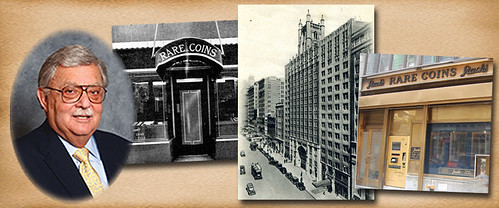
A current article in Bloomberg's Business extols expansion in New York City, with a story about the recently completed “ONE57” building on West 57th Street. As you probably know, 123 West 57th Street is the address of our Stack's Bowers coin store and has been since 1953, when the Stack family, looking toward a future of growth, relocated the shop to the art, cultural and elite shopping center of New York.
The new ONE57 is the tallest office and hotel building in New York, with the first 25 floors a Hyatt hotel. The balance comprises residential apartments; the Penthouse has been sold for $98 million! It is now considered one of the most luxurious and costliest locations in New York. The major portion is so high that it overlooks the entire Central Park located two city blocks to its north.
In the early 1940s, as New York business and cultural establishments moved north of Herald Square, Stack’s moved from 23rd Street to a more prestigious location on West 46th Street. In 1946, at the end of World War II, they moved from 32 West 46th Street to 12 West 46th Street and this store became a home for many famous collectors, as well as for youngsters beginning their collections. Many of these youngsters grew up to become famous collectors. On the second floor of the building just a few steps from Fifth Avenue, they established their own auction gallery.
But neighborhoods sometimes change in New York and many of the locations on 46th Street became discount appliance stores, cheap clothing establishments and by 1953, it was no longer an appealing place for a coin store or gallery and also became less of a "walk in” type of location.
My father, Morton, Uncle Joe (Joseph B.), and I searched for new quarters. As luck would have it we found a vacancy at 123 West 57th Street, (our present location) between the Avenue of the Americas (originally 6th Avenue) and 7th Avenue. This store was a one-block walk from Fifth Avenue, the home of Tiffany’s, Bergdorf Goodman, Bulgari, Black Starr and Gorham, to mention a few high-end retailers on that street.
Also near the new store could be found Carnegie Hall, the famous Russian Tea Room, the Great Northern Hotel (now the Parker Meridian), the last fully operating Horn and Hardart Restaurant (a landmark), the Buckingham Hotel and the Buckingham Steinway Hall. West 57th Street was always considered a fashionable walking street with some famous eateries. While only 11 blocks north of our previous store, it was a great improvement and remains a desirable location today. Accessibility has never been a problem and for those who want to come by train, two different subway lines are located at each corner of the Stack's Bowers shop.
Stack's was lucky to find such a divine location and we built another warm, home-like atmosphere, with sit-down showcases and coins of all value on display or in stock, a section for books and albums for sale, and walls lined with items related to numismatics or to people portrayed on worldwide coins. Collectors came often to Stack’s to view the coins, meet fellow collectors, and discuss numismatics. We had a very extensive library where specialists could gather special information, and our staff was composed of many specialists. Our staff produced a world record number of different auction catalogs and price lists. Many staff members moved on, often to other numismatic endeavors including as curators, and some continued to help Stack’s prepare catalogs.
West 57th Street attracts diverse people, many of whom look in our windows, and some who stop in our shop. You will often see bankers, trust officers, lawyers, actors, directors, writers and authors, politicians and other noted personalities. The street is one of the art centers of the city and only two blocks north is Central Park South, boasting many famous hotels (including the Plaza) and, of course, Central Park itself. Slightly west is Columbus Square, which anchors the southwest corner of Central Park.
Over the decades there have been changes — buildings torn down and new ones erected alongside the older buildings. The charm of the area remains. As Stack’s grew over the last 60 years we expanded to include an entire floor at 110 West 57th Street that includes a special room to display and show lots for a forthcoming auction and offices for catalogers and staff, as well as an auction gallery where we conduct some of our New York City public auction sales.
We welcome collectors and visitors daily from Monday to Saturday. We are open to the public weekdays from 10 AM to 5 PM, and Saturdays from 10 AM to 3 PM. If you wish to buy or sell coins, look at displays or ask questions of our staff we invite you to come by. We look forward to welcoming you, getting to know you and helping you with all your numismatic endeavors. The Stack family recognized the positive attributes of this dynamic location in 1953, and we are proud that we have remained right here, offering the same unparalleled personal service in our great city of New York.
To read the complete article, see:
Revisiting the Coin Shop at 123 West 57th Street, New York City
(www.stacksbowers.com/NewsMedia/Blogs/TabId/780/ArtMID
/2678/ArticleID/64806/Revisiting-the-Coin-Shop-at-123-West-57th-Street-New-York-City.aspx)
THE BOOK BAZARRE
